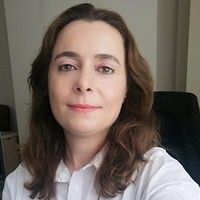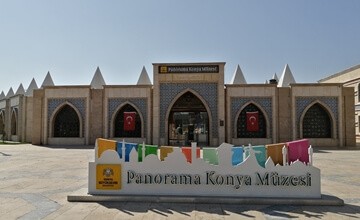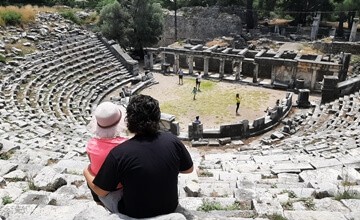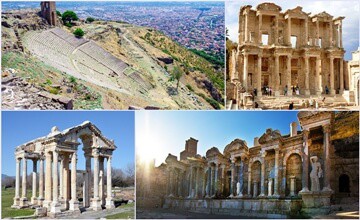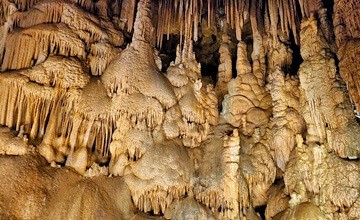What are the must-see parts of Panorama Konya Museum? What are the artifacts in Panorama Konya Museum? Panorama Konya Museum Guide...
Adding Panorama Konya Museum to your itinerary in your Konya trip will add a different meaning to your trip. Especially if you put it at the top of the list, it will allow you to visit other destinations you will visit in a more understandable way.
Entrance to the museum is provided through the entrance gate made in the style of the Seljuk Crown Gate. The selected Mevlevi lodge miniatures that you will see in the courtyard will take you to the Mevlevi schools of the past, the oil paintings that add color to the corridor leading to the main section, and the details of the Seljuk Period works in Konya will show you the intricacies that Konya, the capital city of the Anatolian Seljuk State, had 800 years ago.
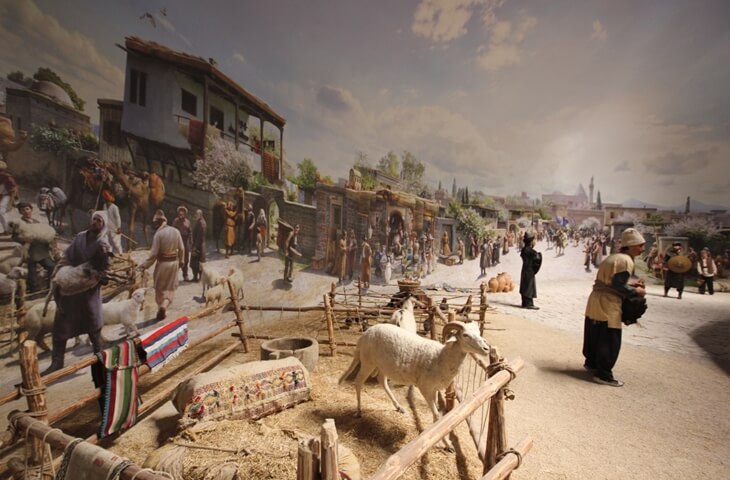
In the 13th century, Konya, which was a scientifically developed city, became the home of hundreds of scholars and mystics. For this reason, it has been referred to as a city where science and art connoisseurs are shown respect and love. Therefore, the museum sheds light on the deep traces of the Seljuk Period and presents it to the visitors.
The artifacts and sections you will see in Panorama Konya Museum will be a useful resource for you to get an idea about the rich past of the city. What you do not know about Panorama Konya Museum, what are the artifacts and sections in the museum?
Location of Panorama Konya Museum
Panorama Konya Museum is located on Aslanlı Kışla Street, located within the borders of Karatay, the central district of Konya. From the moment you enter Konya, you can easily reach the museum thanks to the touristic signs. When you go along the tram line from Alaaddin Hill, located in the center of Konya, towards Mevlana Museum, you reach Panorama Konya Museum, which is on the right side of the road.
You can enter the museum after you park your car in the museum car park located just next to the museum, which is about 500 meters ahead of the Mevlana Museum. Of course, the magnificent entrance door of the museum, made in the Seljuk style, will begin to reflect the first atmosphere of the Seljuks in the museum.
Click for Panorama Konya Museum Location...
Panorama Konya Museum Entrance Fee and Working Hours
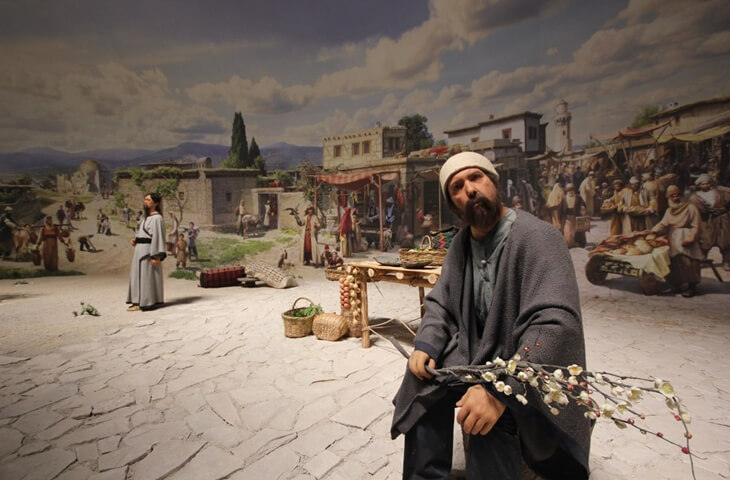
In order to visit all parts of Panorama Konya Museum, it is sufficient to buy a single ticket from the box office at the entrance. Since Panorama Konya Museum has the status of a private museum under the Konya Metropolitan Municipality Museums Directorate, the Müzekart is not valid. It is free for citizens over 65, 6 years old and under, disabled citizens. If you are in the other group, the entrance fee you have to pay is 6 TRY for adults and 2.5 TRY for students. (Fees may vary from year to year).
Panorama Konya Museum visiting hours vary in summer and winter. The museum, which is open to visitors between 09:00 and 18:00 in the summer period, can be visited between 08:30 and 17:30 in the winter period. Although the museum is open on weekends, it is closed only on Mondays per week. It is open to visitors between 10:00 and 16:00 during the pandemic period, but arrangements can be made according to the pandemic conditions. For this, before planning a visit, you can call the museum and learn about the current situation.
PANORAMA KONYA MUSEUM
General Information About Panorama Konya Museum
The Purpose of Establishment, Objectives, Structural Features and Project Team of the Museum

Panorama Konya Museum was built by Konya Metropolitan Municipality and opened on 07 December 2017. It is the first and currently the only museum in Turkey that tells about the turning points of Mevlana's life. At the same time, the 13th century Panorama broke new ground in this sense with Konya of the 1245s. It is a 360 degree domed panorama. It is the second domed panorama after Istanbul 1453 Panorama in Turkey.
Konya Panorama Museum is a museum that enables us to convey information about Mevlana and Mevleviyeh, and is crowned with visual oil paintings, where we can go down to the turning points in the life of the spiritual elder of our Konya, the His Holiness Patriarch. Thus, visitors can both understand the life and thoughts of Mevlana correctly and have deeper information.
The aim of the museum is to introduce the historical places of Konya to the guests coming to Konya, and to show the effects of Mevlana and his family, who lived in the period when those buildings were built, on both the people of Konya and city of Konya itself.

At the same time, Konya is one of the most important centers of the Early Christian Period. It is emphasized that the members of other religions started to accept Islam with the arrival of Mevlana in Konya, and along with his tolerance, Turks, Muslims and members of other religions lived here as brothers and sisters.
In the museum, it is emphasized that together with the tolerance of Mevlana, all members of religions lived in fraternity in Konya. It is even stated that in the scene of the death ceremony of the Patriarch, people belonging to multiple religions participated in the funeral ceremony with great sadness.
The museum is a mirror of the history of Mevlana and Mevleviyeh and the city's 13th century Seljuk Period. The sultans of a city that was the capital of the Anatolian Seljuk State for about 220 years had nearly 10 madrasahs built in the capital. They invited Mevlana's father to Konya for the purpose of educating people in these madrasahs, thus making Konya a center of science. The fact that father of Mevlana, who is the symbol of science and wisdom and love, is known as the Sultan of Scholars, and that he started to preach in one of the madrasahs, clearly shows the Seljuk's aim of spreading knowledge to the world on the way of science and wisdom. Thus, the museum transfers the conditions of this period in history to the present day.
Panorama Konya Museum is the 2nd Panorama Museum of Turkey. Apart from the models in Istanbul and Bursa, it has an intermediate form with a cone ceiling, which is not fully panoramic and unlike the examples in Europe, the sky is partially visible.
Another distinguishing feature is that it has very realistic silicone human sculptures made abroad and brought to the museum in the area where the models are located. It is the second 360 degree domed panorama after Istanbul 1453 Panorama in Turkey. The museum has a total area of 4460 square meters, including the basement and the ground floor, according to the 2017 annual report, together with the large courtyard inside.
The panoramic painting, 28 meters in diameter and 10 meters in height, which is the work of painter, architect Prof. Dr. İlham Enveroğlu and Painter Yaşar Zeynalov, was digitally illustrated and was created by combining digital prints side by side. During the production process of the panorama, Atilla Tunca in 3D models, Bülent İşcan in silicone figures, Prof. Dr. Haşim Karpuz in consultancy on Art History, expert Associate Professor Dr. Şimşekler in obtaining information on Mevleviyeh and Mesnevi, and Associate Prof. Dr. Çağatay Benhür in counseling on history were benefited from.
The main entrance gate of the museum was built in the style of the Seljuk Crown Gates and the miniatures of the Mevlevi Lodge welcome the visitors in the entrance courtyard. In the open courtyard in the middle, there are 20 Mevlevi Lodge miniatures selected from Turkey and the world.
The 17 domes surrounding the courtyard represent the Mevlana Lodge. Two staircase entrances are provided when passing from the courtyard to the museum section. These entrances are Mevlana Gate and Şems Gate. There are symbols and motifs used by the Seljuk State on the embossed panel created between the entrances.

After descending the stairs, the gallery section starts. The oil paintings here highlight the turning points in Mevlana's life. In addition, small miniatures in the windows were made for this purpose. Here, in the middle section, you can go to the panorama section again by climbing a staircase. Panorama of Konya and Mevlana in the 13th century reflects the Konya of that period.
There are also hyperrealistic puppets, silicone sculptures, 3 decorative panels and ceramic panels describing the Seljuk culture in the museum. Every piece of art seen and exhibited in our museum, whose construction and installation was completed in 2017, is new. However, the historical scenes described reflect 800 years ago.
Sections of the Museum
1. Courtyard Section
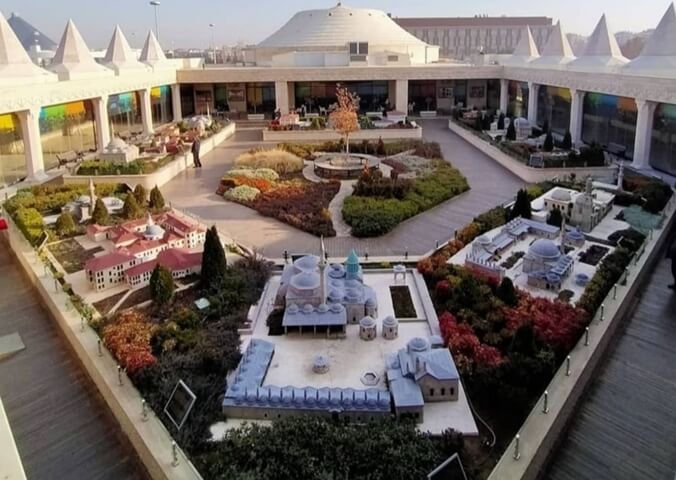
In this section, There are Mevlevi Lodges that were established in Anatolia after the death of Mevlana and continued to exist in other regions under the administration of the Ottoman Empire. Dervish lodges and Islamic monastries known as Mevlevi Lodges have had an important position throughout history.
The fact that the Mevlevi Lodges, which made great contributions to the shaping of Turkish cultural life, were also closely connected to the religion and culture of Islam, caused them to serve humanity on the path of Truth for many years. These structures were used as institutions where training was given in various fields.
The use of music in the Mevlevi recitals has enabled the Mevlevi Lodges to be places where education is given in the field of art. These institutions, which emerged after the death of Mevlana, continued their activities until 1925, when the dervish lodges and zawiyas were closed.
During his lifetime, Mevlana did not apply his Sufi understanding and life for the purpose of a cult system. The Mevlevi cult was founded by his followers who came after Mevlana.
The first example and center of Mevlevi Lodges is Konya Mevlana Lodge. Later, the Mevlevi Lodges built were also connected to the center. The first formation of this dervish lodge started when Mevlana was alive. The first structure of Mevlevi Lodges was formed by adding a few dervish cells to the madrasah where Mevlana taught. After that, they developed their education center identities by adding sections such as Mevlevi lodges, dervish cells, tombs, whirling lodges, kitchen and ordeal lodges, which were developing day by day.
There are 170 Mevlevi lodges in the world and 35 in Turkey. The largest of these is the Gelibolu Mevlevi Lodge in Turkey.
*Selected Mevlevi Lodges from the World and Turkey in the Courtyard are as follows: Cairo, Damascus, Plovdiv, Cyprus-Nicosia, Kilis, Afyon, Kütahya, Eskisehir, Antalya, Tokat, Istanbul-Yenikapi, Istanbul-Uskudar, Istanbul-Galata, Gelibolu, Gaziantep, Sanliurfa, Edirne, Izmir-Tire, Ankara, Mevlana Tomb /Lodge Mevlevi Lodges.
2. Seljuk Panel

On this panel, there are reliefs of the symbols used in the structures of the Seljuk State. It attracts the attention of visitors in a large area right in the middle of the entrances to the gallery.
There are eight-pointed star, double-headed eagle, winged human-angel figure, human-headed bird (tugrul, siren, simurgh, emerald phoenix), rhinoceros and bull relief, and 24-armed star symbols on this painting.
For example, the 8-pointed star symbolizes the 8 gates of heaven and 8 spiritual values. These are mercy and compassion, patience, truthfulness, keeping secrets, loyalty, knowing one's poverty and helplessness, generosity and giving thanks to God. At the same time, the number eight is accepted as the number of cosmic balance, since the sun's rays come to the world every 8 minutes.
The double-headed eagle relief is the coat of arms of the Seljuk State and Sultan Alaeddin Keykubat, symbolizing the protective power and strength. This symbol is also seen in Roman and Byzantine structures.

The 24-pointed star symbolizes the sum of Turkish tribes from Central Asia. Oghuzs are divided into two as 12 Bozok and 12 Üçok. This figure is frequently encountered in the Seljuks.
The human-headed bird relief is an example of relief from Konya Castle. This human-headed bird-bodied creature takes place in Greek mythology as well as in Mesopotamian civilizations as in Turkish culture. Iranians called this figure siren or simurgh, Arabs called it phoenix, Turks called tugrul, and Ottomans called emerald phoenix. It is a legendary bird that represents goodness and benevolence and always comes to the rescue. It was especially used in castles, tombstones and palaces. It is adopted as a protector and bringer of good luck. In addition to Konya Castle, it can be seen on the tiles of Kılıçarslan Mansion and Kubad Abad Palace.
3. Gallery Section
In this section, there are huge oil paintings depicting the turning point events in Mevlana's life from his childhood to his death. In addition, there are hyperrealistic puppets and 3 decorative panels in the windows.
Painting 1: Childhood of Mevlana:

Mevlana was born in Belh, Khorasan in today’s Afghanistan. His father was Bahaeddin Veled, a descendant of Abu Bakr Siddik, known as the Sultan of Scholars, and his mother was Mümine Hatun, the daughter of Alaeddin Muhammed Harizmşah.
Mevlana was at a young age (1212). Bahaeddin Veled decides to emigrate from the city of Belh. They set off with their family and close friends. One of the reasons for this decision is the Mongol Invasions. During their migration, they pass through Nishabur (Iran). Feridüddin-i Attar, one of the valuable scholars of the period, visits Bahaeddin Veled and they chat for a while. During the conversation, he admires the intelligence and interest of Mevlana as a child and gives him a copy of his book Esrarname. He turns to his father and says, "Your son will, before long, will set fire to the hearts of those whose hearts have been burned in the world"... In this painting, this moment of childhood of Mevlana, his father and Attar's life in Nishabur is staged.
Painting 2: Migration Map:
The caravan set off from Belh and reached Nishabur, Baghdad, Kufe, Hijaz, Damascus, and finally the Greek land (Anatolia), passing through Malatya, Erzincan, Sivas, Kayseri, Niğde, and arrived in Karaman at the end of the 10th year. They lived in Karaman for 7 years and during this time, Mevlana made his first marriage with Gevher Banu here. Gevher Banu is the daughter of one of the families in the caravan that set out from Belh.
Mevlana was only 18 years old when he married Gevher Banu, the good-natured daughter of Hodja Şerafettin Lala, a noble and respected person from Samarkand. Mevlana lost his mother here, Mümine Hatun, and his mother's grave is in the current Aktekke Mosque in Karaman. He lost his older brother Muhammed Alaaddin after his mother. Sultan Veled and Alaaddin Çelebi were the sons of Mevlana who were born here, who relieved the sorrows of Mevlana and his father Bahaeddin Veled a little. Mevlana's father, Bahaeddin Veled, named Mevlana’s second son after his deceased son. Now it's time to move to Konya, to the mentioned town, to the city where hearts are hungry for their love, to the last point of migration. In this painting, the migration route of the family from Belh to Konya was drawn and the stopping points were indicated.
Painting 3: The Family's Visitation to Konya upon the Sultan's Invitation:
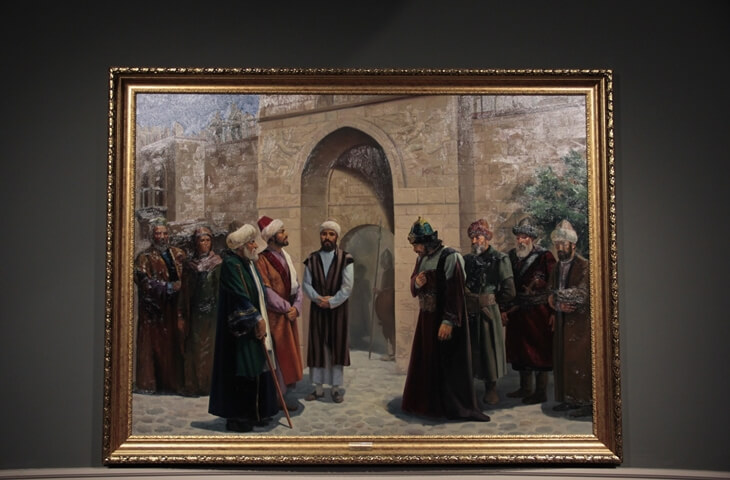
Konya, which was the capital of the Seljuks in the 13th century, became a safe and prosperous city where scholars, craftsmen and poets escaped from the Mongol persecution and settled. Numerous madrasahs built by the Seljuk sultans were filled by students seeking knowledge and wisdom. The Seljuk sultans, who did not fail to respect the lovers of science and art, also developed themselves scientifically. In addition, Konya was a safe city with a castle, where measures were taken against the approaching Mongolian attacks.
Many scholars lived in Konya until Mevlana and they contributed to the development of the city in this sense. Finally, the sultan of the period, Alaeddin Keykubad, wanted to include Bahaeddin Veled in this parade of scholars living in the city. Persistent invitations yielded results and the family decided to settle in Konya.
At the Karaman-Larende Gate, one of the gates of the Konya Castle, Sultan Alaattin welcomed the family with the notables and amirs of the period. He wanted them to come to his palace, but Bahaeddin Veled rejected this offer, saying that it is enough to allocate a madrasah for them. Thereupon, the İplikçi (Altun-Aba) Madrasah was assigned to them.
Continuing his teachings here, Bahaeddin Veled passed away at the age of 80, about 2 years after he came to Konya. His son Mevlana continued these conversations. The Sultan of Scholars was buried in the rose garden of the Seljuk Palace, which was given to them as a gift due to the family's arrival in Konya and where the sultan received inspiration. The garden where the current Mevlana Museum is located is this garden. In this painting, the moment when the Sultan and the notables of Konya greeted Mevlana's family from the castle gate of the city was staged.
Painting 4: Halaviye and Makdemiyye Madrasahs:

Mevlana was busy with his education in his childhood, and at the request of His Holiness Burhanettin Muhakkik Tirmizi, who was one of his father's disciples, he went to Halaviye Madrasah in Aleppo, within the borders of current Syria. Two years after the death of his father, he was sent to this madrasah in order to advance in apparent sciences. Mevlana, who stayed here for about 4 years, received training in sciences such as fiqh, tafsir and hadith and returned to Konya. He took lessons from Kemaleddin İbnül Adim in this madrasah.
Kemaleddin Adim was both the manager of the city and the professor of this madrasah, where students from around the world came to add knowledge to their knowledge. In this painting, Adim, Mevlana and the students studying in the madrasah are staged in the courtyard of the madrasah (Risale-i Sipehsalar, Feridun; p: 24,25,30). In addition, Mevlana's meetings with Muhyiddin İbnu'l-Arabi and Sadreddin Konevi in Damascus Makdemiyye Madrasah are also tried to be conveyed.
Painting 5: Meeting Scene of Mevlana and Şems-i Tebrizi:
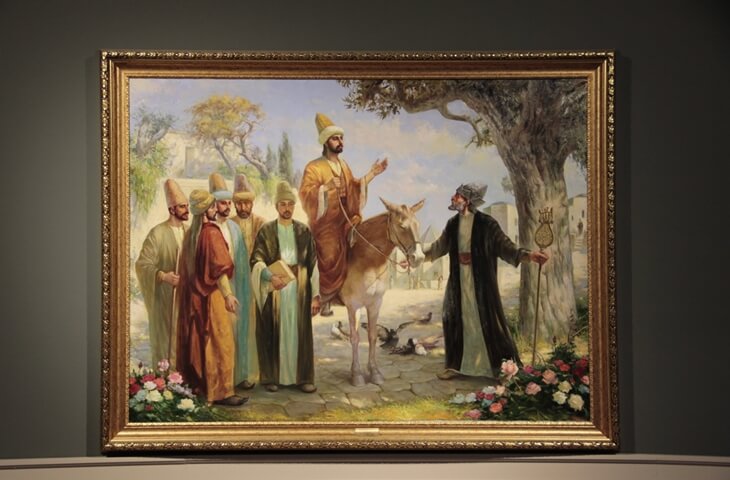
Şems-i Tebrizi (The Sun of Tabriz) is one of the Azeri Turks, and his real name is Muhammed Şemseddin. His other nickname is Şemsi Perende (Flying Şems). He was called with this nickname because he could not get enough of knowledge and traveled the land to add new ones to the sea of knowledge, and could not stay at one point for a long time.
Şems, who had very different behaviours and perceptions from his peers in his childhood and youth, was born in Iran. Finally, he set out to find an equal to whom he could love to his heart. It was reported that the lover of God he sought was in the Greek land and he came to (Menakıbü-l Arifin, Eflaki; 1,84; 2,618). Probably, Şems settled in the Şekerciler Inn in Konya.
One day, when Mevlana finished his talk in the madrasah and was walking on his mule with his students, Şems saw him from the window of the inn where he was staying and went out. He got in front of his mule and caught its bridle. He realized that he was the sea of knowledge he was looking for, and asked tough questions one after another (was the Prophet Muhammad great or Bayezid-i Bistami?). Şems was enchanted by the answers he received. He embraced Mevlana, a great friendship started, and the two retired to the madrasah.
Şems, who opened a new window in Mevlana's world, plunged him into a great sea of interrogation and dragged him into quests in the world of public affairs. Mevlana became the most brewed wine of love, and Şems became the glass for him. In the end, he was called from the dervish lodge one night by those who begrudged this friendship, and no one saw Shams again after that period (1247). For these reasons, he moved away from Konya many times, but returned for Mevlana. But this was his last goodbye.
Mevlana has never been the same as before. Now, with Shams on his chest, kindlings have burned. Şems' students gathered his words in the assemblies after his death. This is how Şems’ work called Makalat emerged. There are representative tombs in many countries as in Konya. In this painting, the place called Meracel Bahrain, where they meet, and the meeting of these two seas are staged.
Painting 6: The Story of Mevlana and Şems of Tabriz Throwing the Books into the Pool:
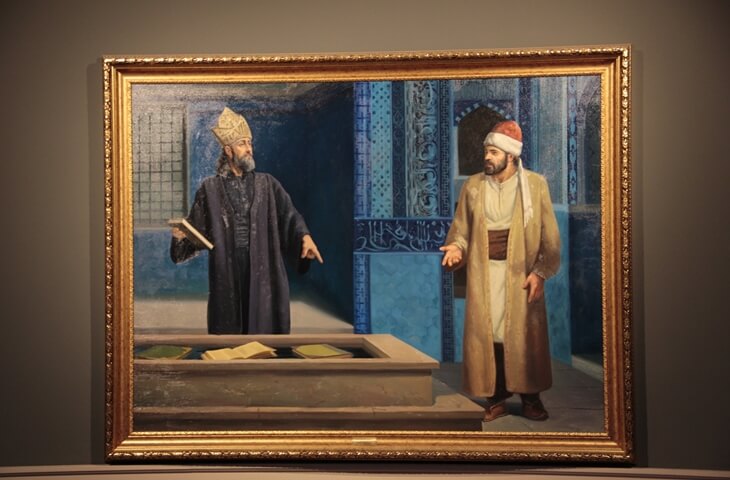
During one of the days they spent in the madrasah, Şems threw the books of Mevlana into the pool. These books, which he read for years, had became a part of his life. Some of them are the books of his father and some of the teachers who were the sea of knowledge who educated him. The pool is painted in ink. Like every event that happened between them, Şems created revolutions in Mevlana's mind, trying to teach that he should not look for the science of state in matter, but on the contrary, he cannot reach meaning unless he is separated from matter. In this painting, while Şems and Mevlana were by the pool, Mevlana's books were depicted in the pool and this event was staged.
Painting 7: Mevlana and Selahattin Zerkubi:

Zerkubi is one of the people assigned to serve, who can join Şems and Mevlana in the early days after they met. He is the son of a family living on fishing by a lake in Konya. In his youth, he was inspired by the conversations of Burhaneddin Tirmizi. Zerkubi is a man who makes a living by making gold leaf in a jewelry store. After losing Şems, Mevlana took Zerkubi as a friend and tried to relieve his sadness. He was carried away by the sounds of his gold forging and started to whirl. He married his eldest son Sultan Veled to his daughter Fatma Hatun and wanted to strengthen the bond between them. In this painting, the friendship between this person and Mevlana and the moment of consolation in the absence of Şems are staged.
Painting 8: The Stance of Mevlana at the Time of the Mongol Invasion and the Liberation of Konya:

The Mongols dispersed the Seljuk army in 1256 and entered Konya. They did not engage in plundering, destroying and killing, taking a huge amount of tribute. Only a few of the bastions were demolished in order to fulfill the Mongol commander Baycu's promise to "destroy and raze Konya, the Seljuk capital,". The people were worried about their lives and started to say farewell to each other. At the same time, they asked for a prayer from Mevlana, who was living in Konya at that time, for the salvation of the city.
Mevlana, wearing his green robe, went to a high place, where Mongolian soldiers could see him, and started to perform the morning prayer. Realizing that Mevlana was there, Baycu Noyan was impressed by his majesty and left the city without slaughter. In this painting, this moment of the Mongol army besieging the city, Commander Baycu Noyan and Mevlana is staged.
Painting 9: Map of Mevlevi Lodges Around the World:
There are approximately 170 Mevlevi lodges in the world. The countries and cities they are in are shown on this map. Large-scale Mevlevi lodges are also designated as grand lodges. These dervish lodges were established in the lands where the state ruled during the Ottoman period, and they served as scientific and educational institutions in the places which were taken. They helped the development of the people in terms of science and provided services. At the same time, they played an important role in raising the awareness of the Anatolian people and raising national consciousness in the Republic Period and the War of Independence. In this table, the Mevlevi Lodges and their locations are indicated.
Painting 10: Mevlana's Last Days in the Sick Bed:

Mevlana sensed that he was living his last moments and that he would reach the eternal realm that he longed for. He fell ill suddenly and fell into bed. At his bedside are his son Sultan Veled and Physician Gazanfer. People come to wish healing and to receive his prayers. One of them is Sheikh Sadreddin-i Konevi, one of the scholars of the period. He went to visit Mevlana with his students. He expressed his sadness and wished for healing.
Mevlana replied, "Don't you want the lover to reunite with his beloved, may God give you health from now on, it's time to meet." Before long, on December 17, 1273, at the end of the afternoon, he met his Supreme Beloved in the evening crimson. He made wills before meeting. He said don't mourn after my death, don't groan. Because he was in great joy and excitement. That's why he said that “my death day is my wedding day, my bride's night” and tried to explain the extent of his excitement. His Reunion Night has come to life all over the world and is celebrated and commemorated with ceremonies every year. In this painting, Mevlana in his sickbed, those who come to visit him and these moments are staged.
Painting 11: Mevlana's Death and Funeral Ceremony, Reunion Night (Wedding Night):

Despite all the treatment efforts of the Seljuk Palace doctors, Mevlana could not get rid of the disease and passed away on 17 December 1273 and reunited with his Beloved. Upon Mevlana's will, Sheikh Sadreddin Konevi wanted to lead the funeral prayer, but he fainted because of the loss of his close friend and could not do this prayer. Instead, the Kadi of the time, the Kadi Siraceddin Urmevi, completed the last duty.
All the notables of the Seljuk palace, professors, students, people from all religions and sects and their leaders were present at the prayer. In the İbtidânâme of his son, Sultan Veled, it was stated that not only Muslims but also Christians and Jews were deeply saddened by this death. A candle went out in the world. However, his teachings will continue to illuminate the whole world forever. He was buried in his eternal place, in his tomb where the Mevlana Museum is located, next to his father's side. In this painting, the funeral ceremony of Mevlana and the participants in the ceremony are staged.
Decorative Showcase Stagings in the Gallery Section
The artists continued to detail the events with 3 stages here. The protagonists of the story are given in the form of hyperrealistic puppets with small miniatures.
Showcase 1: Mevlana And Burhaneddin Muhakkik Tirmizi:

When his father passed away, Mevlana was twenty-four years old. He (Mevlana) succeeded his father by his father's will, the order of the Seljuk sultan and the insistence of Bahaeddin Veled's followers. Later, Burhaneddin Muhakkik Tirmizi, who learned of his father's death and was one of his students, came to Konya from Tabriz and did not leave Celaleddin alone. He started his education life with his father and continued with Tirmizi. He tested Mevlana in Islamic sciences, and after his success he said, "You have no equal in knowledge, you are truly distinguished, but you must be trained in the knowledge of the state."
After that, he went through the education of Tirmizi for about 9 years. Now it was time for Tirmizi to return to Kayseri, and his duty on Mevlana had been completed. He brought him up as he wanted. Mevlana did not want to leave him, but he convinced him by saying "two lions cannot be found in a field". By saying, "A friend will come to you after me, you will complete each other," he informed him that the person who will be a mirror to him (Şems) would come. In this showcase, the conversations of Mevlana and Tirmizi in the dervish lodge are animated.
Showcase 2: Şems of Tabriz And Mevlana in Zerkubi's Cell:
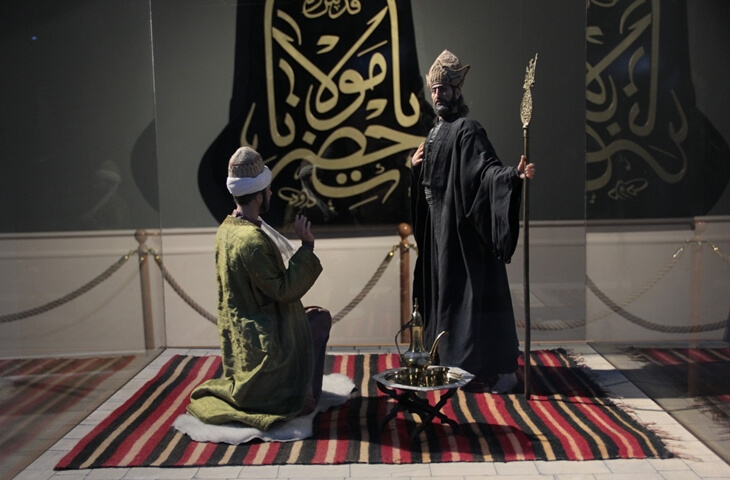
After Şems came to Konya, Mevlana and Şems chatted for months in Zerkubi's cell. Zerkubi and Mevlana's eldest son Sultan Veled waited for their temple door and served. During this period, Mevlana became more mature. Mevlana summed up his life by saying "I was raw, I was cooked, I was burned".
His cooking started with his father Bahaeddin Veled and his teacher Tirmizi, and his burning started with the arrival of Şems. In this showcase, Şems holding a mirror to Mevlana, trying to show him the beauty of his heart, and the moments of conversation in the first days about this are animated.
Showcase 3: The Writing of the Mesnevi:

Çelebi Hüsamettin was the clerk of Mevlana and the person who wrote his works. He was a student who was brought up and matured with Mevlana's upbringing. It is mentioned that Mevlana recited poems and sang ghazals while walking and watching the currents of the cascading streams in Meram Vineyards. Çelebi Hüsamettin wanted these poems to be written. He said that not only they, but also other generations should benefit from his poems. Mevlana said, "If you write, I will say" and took a piece of paper from the edge of his turban and handed it to Çelebi.
The writing of these verses started with the first 18 couplets of the Mesnevi. After that day, he said it day and night, in the vineyard, in the garden, on the road, and Çelebi wrote it. The Mesnevi, which began to be written in this way in 1258-1259, was completed in 1268. About 5 years after its completion, Mevlana passed away. In other words, the Mesnevi was written during his maturity period. In this showcase, the story of the writing of the Mesnevi, which is translated into approximately 29 languages today, is animated. Currently, Mevlana has 5 works. These are Divanı Kebir, Mesnevi, Fihi Ma Fih, Mecalisi Seba and Mektubat (Letters).
4. Panorama Section
In this section, it is explained that Konya, which was the capital of the Anatolian Seljuks for about two centuries in the 13th century, was a city where scholars, artists, poets and literary men were blended. In particular, scholars, sufis, craftsmen and traders who escaped from the Mongol invasion and took refuge in Anatolia took their places in the image.

The fact that the city was located on the Silk Road and was a safe city made it a frequent destination for traders. At that time, the Seljuk Sultans had inns-caravanserais built in the center and its surroundings so that the caravans could rest and stay safely. Again in this section, there are merchants and an example of an inn.
The arrival of Muhyiddin-i Arabi, who is considered one of the greatest mystics of this period, to Konya and the presence of Sadreddin Konevi in Konya accelerated the development of the city in terms of Sufism. In this century, the mystical life, as well as the scientific life, advanced in Konya as a result of the activities of the Seljuks in the 11th and 12th centuries.
Although Konya was exposed to internal attacks by Baba Rasûl and external Mongol attacks during this period, its scientific development continued. The reason for this is that hundreds of scholars and mystics escaped from the Mongol danger and settled in Konya. Another factor is that the sultans and begs, who were known for their respect and love for the connoisseurs of science and art, and who were also scholars and poets, ruled in Konya during this period.
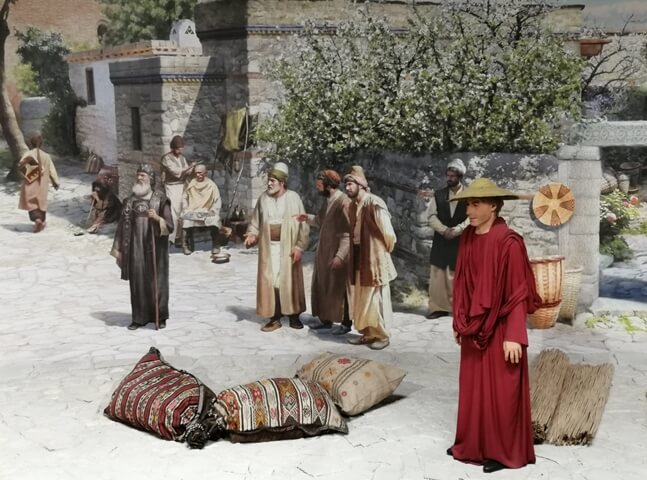
In addition, at that time, Konya was one of the most important centers of the Early Christian Period. In the years when Christianity first started to spread in Anatolia, they migrated to Konya. The appearance of a saint and a priest in the Konya bazaar in the 1245's Konya Panorama, which shows that Muslims and Christians (Turkish-Greek) lived together in fraternity, shows that the understanding of tolerance in Konya from that period has been the basis of this period and that it sheds light on the spirit of Konya now. In addition, pottery, ceramics and felt shops are included in the visuals in Konya's covered bazaar. This emphasizes that our traditional handicrafts were of great importance in conveying our culture at that time. Today, there are masters who continue this tradition and their workshops in Konya.
*Panorama Section Important Details Are Given Below Under The Headings:
1. Whirling in Covered Bazaar:

We do not have any source about when and why Mevlana first performed the whirling. He was carried out in the dervish lodge, at home, in the market and sometimes during the lesson, and performed the whirling as he felt, without being subject to any rules. During the years that Mevlana spent with Şems, he also performed the whirling with him many times. There is detailed information in the sources that Şems also supported Mevlana's whirling.
One of the stories told is that after the disappearance of Şems of Tabriz (1247), he was carried away by the rhythms of the hammer blows and started whirling while passing by the goldsmith shop of the Jeweler Selahaddin, whom he chose as his comrade.
During One day, while Mevlana was wandering around the streets of Konya, he was delighted by the tune of a Turkmen who was selling the fox's skin he had hunted by shouting "dilku, dilku" in his own dialect, and he started to whirl there. Because the word 'dilku' in Persian means "Where are you, my heart?" Understanding the word in this sense increased the love in Mevlana's heart, and he started to whirl with this love.
Mevlana has managed to enter the hearts of all the people of the world with his whirling, which he described as "being with Allah". It is explained in detail, especially in Eflâkî Dede's Menâkıbu'l-Arifîn, that Mevlana directed the Whirling assemblies and performed the Whirling together with the participants in meetings he was invited, both in the Seljuk palace and in the surrounding cities. Whirling is not an act of worship. Mevleviyeh is not a religion either. You should understand this well and be sensitive about it while explaining it. This scene is depicted in the image in this detail of the panorama.
2. İplikçi (Altun-Aba) Madrasah:
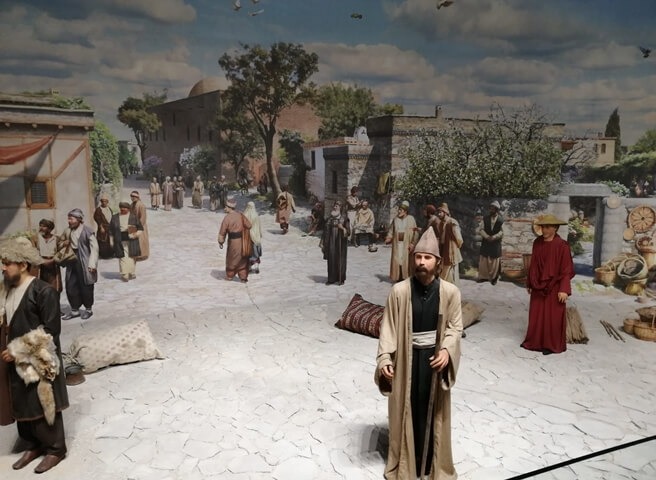
Although the mosque part has survived to the present day, the madrasah, which was right next to it, has not survived. It is estimated that it was built in 1202. When Sultan Alaeddin Keykubat invited Mevlana's father to Konya, the family came to Konya and the madrasah was allocated to the Sultan of Scholars by Alaeddin Keykubad. With the death of his father, Mevlana took over these conversations and sermons, so the madrasah was used as an important religious center for a long time. The madrasah was overflowing with people from every corner of Anatolia who wanted to listen to his conversations. The madrasah took its place in the panorama, and the conversation of Sadreddin Konevi and other scholars is depicted right next to the madrasah.
3. Sırçalı (Glass) Madrasah:

It is a madrasah built by Emir Bedreddin Muslih in 1242/1243 during the reign of Seljuk Sultan Gıyaaseddin Keyhüsrev II. It is one of the rare structures of the city of Konya, which was decorated with madrasahs in the 13th century. It is a madrasah that has survived to the present day. It was built for fiqh scholars and students who acted according to the Hanafi sect. The domed rooms on the right and left of the main iwan of the building, which was built in the "Open Courtyard Madrasah" type, were used as winter classrooms. Some parts of the building and the iwan are decorated with tiles and verses, reviving the spiritual atmosphere of the madrasah. This madrasah is depicted in the image in this detail of the panorama.
4. Konya Castle-Inner Castle-Aladdin Hill:
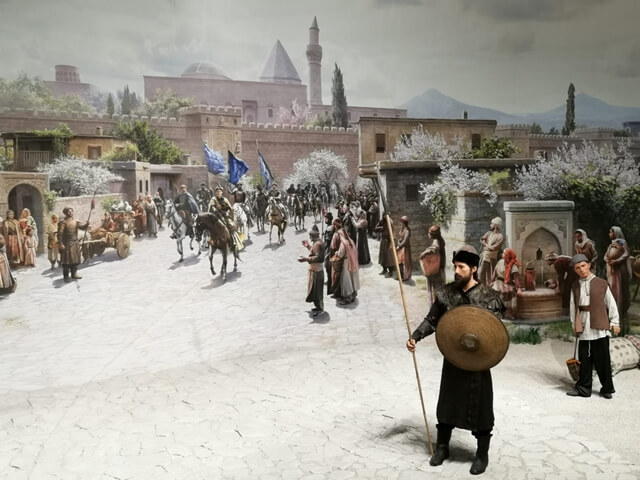
Alaaddin Hill, which forms the center of the city, is one of the mounds that have been used regularly since 2000 BC. Konya (Kavania), which developed in the Inner Castle surrounded by walls during the Phrygian period, became a castle-city. On this hill, there was an official military building and other units during the Byzantine period. To protect these important buildings and institutions, they surrounded the hill with high walls. In the face of danger, the people could take shelter here if necessary. It was built for the protection of important structures such as water and supply stores and arsenal. The castle was decorated with reliefs of lions, rhinos and elephants made of stone and marble.
During the reconstruction and settlement activities that started after the Seljuks captured the city, the walls were also repaired. Sultan Alaeddin Keykubad I took the city under protection by enclosing it with a second wall from the outside (1221). There were also castle gates opening to various directions on this approximately 7 km long wall. These walls, fortified with bastions, were decorated with paintings, reliefs and sculptures consisting of human, animal, angel, simurgh, dragon, lion, fish, bird, eagle and stone. Some of them were from the Byzantine Period. The "Double Headed Eagle" symbolizing the state was one of them. Some of the remains of this structure, which has not survived to the present day, are exhibited in the Ince Minare (Thin Minaret) Museum, where Stone and Wooden Artifacts are located. In the image in this detail of the panorama, the inner castle and partially the outer castle are depicted with their appearance at that time.
5. Alaaddin Complex:

Alaaddin Mosque, which is the largest and one of the oldest works of Seljuk Period in Konya, is located on Alaaddin Hill in the city center. After the Anatolian Seljuk Sultans took Konya from the Byzantines and made it the capital city, they had a palace and a mosque built on this hill, which is surrounded by an inner castle in the middle of the city.
The construction of the mosque started in the last periods of the Seljuk Sultan, Rükneddin Mesud the 1st, and continued during the reigns of the Kılıçarslan the 2nd and the İzzeddin Keykavus the 1st, and was completed in 1220 during the reign of Sultan Alaeddin Keykubad the 1st.
The mosque bears the architectural features of the Seljuk period. It consists of a flat roof and has a rectangular plan. The first mihrab of the mosque was built in the Seljuk period, and the area around the mihrab was decorated with verses using turquoise tiles. During the reign of the Ottoman Sultan Abdulhamid II, a marble mihrab was placed here, and a dome trial was made just above the mihrab. The pulpit of the mosque was made by Mengüm Berti of Ahlat using ebony wood inlay art and was completed in about forty years. Sultan gathering place was added during construction.
When entered through the crown gate of the mosque, the marble columns belonging to the Roman and Byzantine periods attract attention. In total, 57 marble columns were used as spolia material in the construction of the mosque. In the courtyard, there is the Sultans Tomb where 8 Seljuk sultans are buried. In addition, a building, which is thought to be an unfinished tomb to which an altar was added later, the water cistern and the courtyard walls complete the structure.
On the slope of the mosque facing the Karatay Madrasah, there was the Seljuk Palace, which was completed in the period of Kılıçarslan the 2nd. Only a fragment of the wall of the palace has survived to the present day. In addition, there is a water tank close to the mosque, which used to meet the water needs of the city. In addition, the mosque was used for the army in the World Wars I and II and the War of Independence, and was restored after the war and opened for worship. In the image in this detail of the panorama, the Alaaddin Complex with its appearance at that time is depicted.
6. Eflatun Masjid:
It is a building that was converted from a church in Konya and used as a mosque and then as a clock tower and does not exist today. It was located on the Alaaddin Hill. In the sources, it is mentioned with names such as Amphilokios Church, Platon Observatory, Clock Tower.
Another name of Akmanastır (White Monastery), between Konya and Sille, in Seljuk sources is Deyr-i Eflatun. The attribution of the Platon-Eflatun narration to the church in Konya probably goes back to the Byzantine era, even earlier than the Seljuk period. At the beginning of the Ottoman administration, this church in the city was converted into a mosque under the name of Eflâtun Masjid. It is reported in the records that the Eflatun Masjid was used as a mosque until the beginning of the 19th century. In the image in this detail of the panorama, this building is depicted with its appearance at that time.
7. The Sultan's Welcome Scene:

From the palace in the inner castle on Alaattin Hill, the first ascent of the newly ascended sultan to the throne with his combatants on his horse and the moment of his welcome by the people of Konya has been animated. İzzeddin Keykavus II inherited the throne after the death of his father Gıyaseddin Keyhüsrev II. Since the 1245's and later was portrayed, this sultan should most likely be Izzeddin Keykavus II. This scene is depicted in the image in this detail of the panorama.
8. Karatay Madrasah:

The madrasah, which is still under construction in Panorama, was completed in 1251. It was built by Emir Celaladdin Karatay during the reign of Seljuk Sultan İzzeddin Keykavus II. Celalettin Karatay, an astronomer of the period, was also an important statesman.
In addition to religious education, studies on astronomy were also carried out in the madrasah. The building, which is in the madrasah with a closed courtyard type, is used as a museum where tile works are exhibited today. This madrasa, whose main portal was decorated with hadiths, and its iwan and dome drum with verses, was one of the most important institutions of higher education of the period. This madrasah is depicted in the image in this detail of the panorama.
9. Güdük (Stump) Minaret and Hatuniye Masjid:
Although the mosque has not survided to the present day, its minaret has survived from the 1200s, when it was built, to this day, with a single balcony. It is also stated that it was a complex in the past. There are some rumors that the minaret used to have three balconies. The minaret, whose turquoise tiles were made with mosaic technique, now has a single balcony with stalactite. In the stalactite, there are figures of the Star of David, the Seal of Solomon. This minaret and masjid are depicted in the image in this detail of the panorama.
Yazının Türkçesi için aşağıdaki linke tıklayınız.



